This was published 6 years ago
India tour: How to see India in a one-off adventure - Delhi, Jaipur, Agra
By Brian Johnston
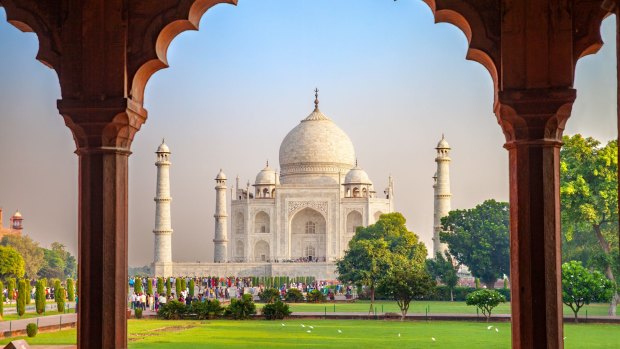
Taj Mahal, Agra, India.Credit: Shutterstock
India is bold and beautiful and has no iota of shyness. It's only day one in Delhi and already India has erupted in blushing mosques, red ruins and bold Mughal tombs, all interlaced with startling dollops of traffic and cacophony. Modern Delhi is somewhere else, and we trundle through a city of magnificent dilapidation and historical grandeur in red and orange. Scarlet saris flash, cycle-rickshaws dangle with tinsel and – wait a minute! – is that a camel daubed in pink and sporting red toenails?
Our morning starts early. There's a lot to see in India, and for most of my travelling companions this is a one-off adventure. Even monuments we've never heard of confound with their splendour. Our first stop in Delhi is Emperor Humayun's tomb, big as a shopping mall, a pile of purple-red sandstone inlaid with white marble in a kaleidoscope of arches and latticed windows. The 16th-century monument, suffused with Persian influences, is a gloriously beautiful building that inspired the design of the Taj Mahal. It ought to be world famous.
Deeper into the old town, the Friday Mosque is magnificent too. Twenty-five thousand people can fit into its courtyard. Bearded men gather under arches, reclining on patterned Kashmir carpets. The stonework flushes deep red, and minarets are striped like giant candy sticks. Its ceremonial gateway towers over the streets below, grand and imperious. As always in India, though, it's but a few steps from the sublime to the tumultuous.
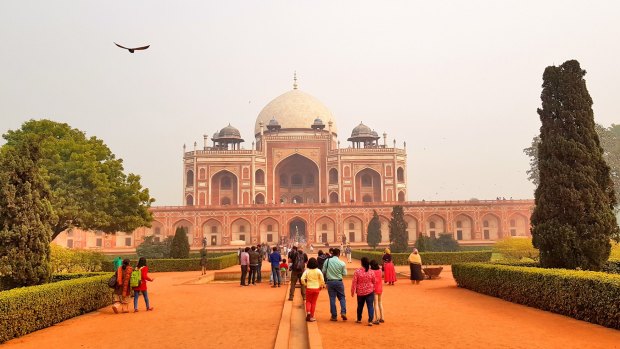
Mughal Emperor Humayun tomb was commissioned by his wife Bega Begum in 1569-70, designed by Persian architect Mirak Mirza. Many Mughal rulers lie buried here.Credit: Shutterstock
This part of Delhi is a jam of wandering cows and hobbling sadhus, moustachioed Sikhs, copper workers and street vendors and limping beggars.Our accompanying tour concierge Virendra, perhaps sensing some people's alarm, bundles us into cycle-rickshaws that set off into the warren of alleys. We're shielded from the tumult but can observe it all: the polyester clothes and sacks of tea, the rolls of textiles and tin buckets, the car parts, crockery and pyramids of turmeric and dried mango.
One street blazes with garish wedding finery: garlands of rupee notes stung together, beribboned bridesmaids' dresses, red wedding gowns weighed down with ruffles and spangles. Elsewhere, giant woks sizzle with samosas. Street barbers, mirrors hung from tree branches, tend to rickshaw wallahs.
"I don't just want to show you monuments and things that are shiny and sparkly," says Virendra, beaming at our goggling and occasional dismay. He'll accompany us on our entire Luxury Gold holiday, faultless in his organisation and an oracle of information, though never prattling in that annoying tour-guide way. When he speaks, he's worth listening to, especially for his lovely, slightly odd Indian English. "The weather is very loveable!" he cries. "Pay attention on the hot, hot coffee!"
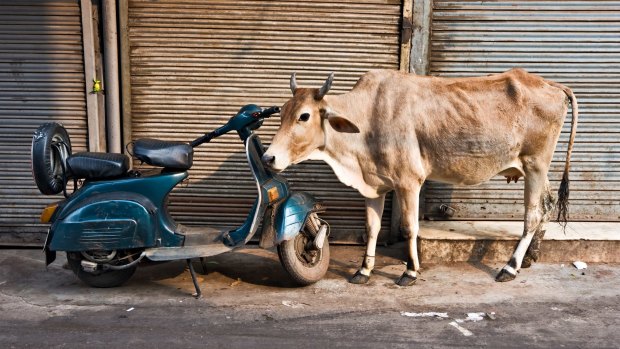
A Cow and scooter, Paharganj.Credit: Shutterstock
Many things are repeated twice, as if a single word isn't enough to capture the boldness of India. "Look at this, it's big and enormous!" he says as our coach sails past India Gate. New Delhi is a madness of British-built monuments in salmon pink. The viceroy's house is bigger than Buckingham Palace and twice as ugly. Around it spread avenues of high-walled bungalows inhabited by politicians and retired generals. We arrive at our hotel exhausted but exhilarated at Delhi's outrageous extravagance, repeated across centuries.
Next day we drive south to Agra along a highway eerily empty, lined by abandoned high-rise developments. After lunch, we're off to the Red Fort – you need stamina for this holiday – from whose ramparts we get our first teasing glimpse of the Taj Mahal downriver. But the fort itself commands attention. It was the seat of three of the most impressive Mughal emperors, when Agra was at its zenith as a centre of commerce and culture. Its crescent-shaped ramparts run for two kilometres along the riverfront. It has four massive gateways, and courtyards, mosques, audience chambers and gardens where green parrots squawk. Geometrical carvings, statues of dancing girls and ornamental eaves bequeathed by Hindu architecture blend with Islamic arched windows and cupolas. The fort's sandstone glows spectacularly in the late afternoon sun. Down below in the river, women in bright saris thwack clothes and kids pester oxen with sticks in the casual juxtaposition of the magnificent and profane in which India so casually specialises.
You never know what you'll see next on an Indian street, and my coach provides an elevated seat from which to stare out at its antics and improbabilities. Few destinations are as suited to an escorted journey. To an outsider, this is a destination of chaotic muddle, travel impracticalities, dusty heat and such a passing spectacle that, by day's end, you brain falls into exhausted disbelief. Yet its impact is alleviated by the shared experience of our friendly group, by reliable organisation, and by Virendra, who interprets and soothes our way around Agra and on towards Jaipur. If we'd packed up and gone home that night, we'd have considered Indian monuments remarkable. The Taj Mahal next day effortlessly undoes everything that has come before, however. We've seen it in magazines and on television, but the real thing springs stupendous surprises. The Taj is enormous and yet delicate, almost ethereal, and is surrounded by several other impressive buildings in contrasting red sandstone. Our group has wisely arrived early, and it isn't nearly as crowded as I'd anticipated. I wander through the gardens to capture photos of the monument with scarcely a person in sight.
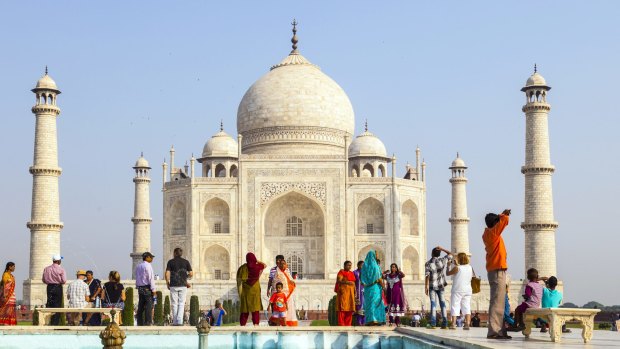
The Taj Mahal, Agra.Credit: Shutterstock
If Delhi is red and Agra white, then Jaipur a few days later is pink. It has pink fortifications and pink streets, and women in pink saris, and regal-looking men in pink or red turbans. The fabulous Hawa Mahal has five storeys of dark pink balconies and latticed windows that were once a grandstand from which the maharaja's harem could peer at passing parades. The adjacent City Palace is pale, but colour erupts again in its museums. Virendra lead us past dainty miniatures and gigantic carpets and court garments spun with gold and silver thread.
Jaipur city is laid out around the palace in a grid of streets laid down in the 1720s by erudite and science-minded Maharaja Jai Singh II. Everyday life, with Indian exuberance, spills from the city's chequerboard in a riot of cotton and silk, marble statues and Rajasthan puppets, garlands of temple flowers and surging scooters. We journey onwards through the spectacle, astonished once more.
FIVE MORE TOUR HIGHLIGHTS
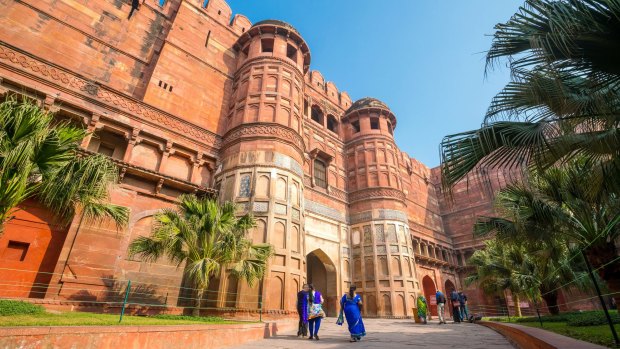
Heritage site Agra Fort (or Red Fort) in India.Credit: Shutterstock
QUTB MINAR
This splendid 12th-century Delhi monument complex features India's largest stone tower, rearing over a ruined mosque carved with decorative bands and Koranic inscriptions. Ornamental arches and carved sandstone screens lie scattered all around. Our group arrived an hour before sunset to find the monument's red sandstone aglow.
KACCHPURA VILLAGE
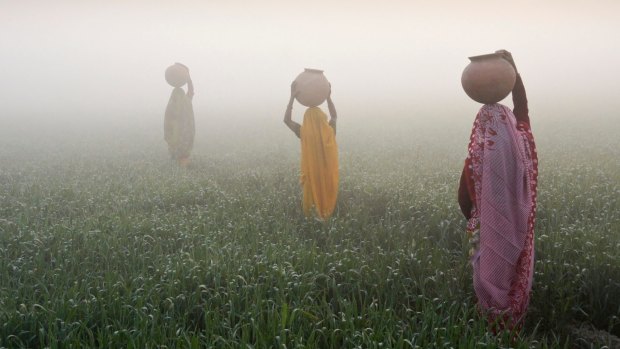
Women carry jugs through a field of rice at sunrise on a foggy morning. Credit: Shutterstock
This Agra village sits across the river from the Taj Mahal. A villager-led tour provides a welcome insight into semi-rural life, and finishes with pakoras and tea on a rooftop with Taj outlooks. Views onto goatherds, buffalos and women in bright saris returning from the fields are compelling, too.
RANTHAMBORE NATIONAL PARK
Between Agra and Jaipur, this former royal hunting ground is one of the best places in India to tiger spot. Other wildlife includes deer, langurs and spectacular bird life. The rugged landscape features a Ganesh temple and ruined monuments straight from the romantic sketches favoured by colonial-era memsahibs.
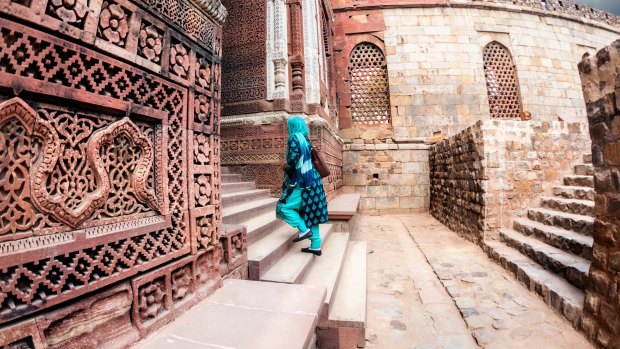
Woman at ancient Qutub Minar Complex in Delhi, India.Credit: Shutterstock
JANTAR MANTAR
A knowledgeable guide is a must when touring this 18th-century observatory in Jaipur's palace complex. The huge sundial at its centre, 27 metres high, provides the correct time to within two seconds. A host of other instruments measuring time and the location of planets is just as astonishing.
AMBER
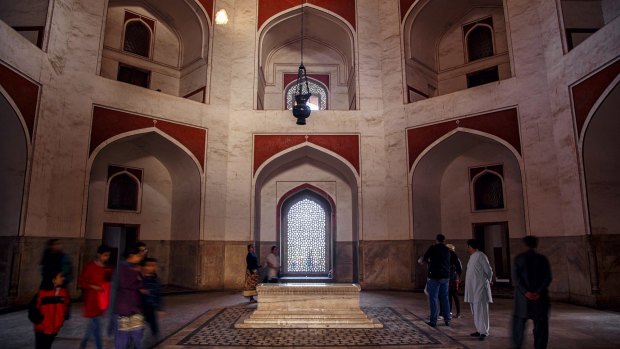
The interior view of Humayun's tomb which is a World Heritage architecture, situated in Delhi, India.Credit: Shutterstock
Just outside Jaipur, forbidding Amber Fort conceals a pleasure-palace interior in a refined Islamic-Hindu blend. Walls are painted with hunting scenes and studded with semi-precious stones and mirrored tiles. Amber town below is often overlooked, but an insider Luxury Gold tour takes guests on a fine wander through atmospheric streets and exquisite temples.
TRIP NOTES
MORE
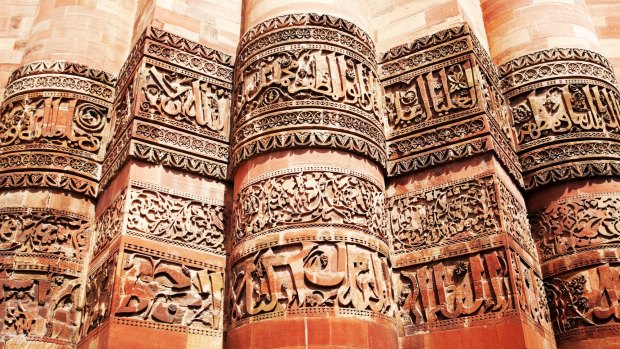
Detail of Qutub (Qutb) Minar, the tallest free-standing stone tower in the world, and the tallest minaret in India, constructed with red sandstone and marble.Credit: Shutterstock
TOUR
Luxury Gold's eight-day Essence of India with Ranthambore holiday visits Delhi, Agra and Ranthambore National Park and ends in Jaipur. Highlights include the Taj Mahal and an Agra village experience as well as visits to Amber Fort and old Amber. Prices from $3595pp including accommodation, transport, VIP experiences and dining. Phone 1800 001 783, see luxurygoldvacations.com
Brian Johnston travelled courtesy of Luxury Gold.
Sign up for the Traveller Deals newsletter
Get exclusive travel deals delivered straight to your inbox. Sign up now.